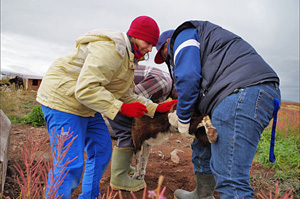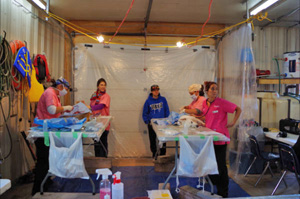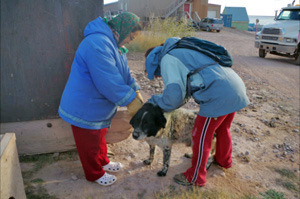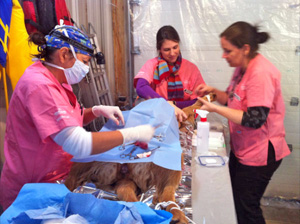From the Editor
Astrup’s Harness
Akunnirmiut Nunavut Quest, Pt. 2
Sleds, Dogs and Nitrate Film
In the News
Fan Mail
CAAT 2012 Baker Lake Animal Wellness Clinic
Book Review: Kamik, an Inuit Puppy Story
Movie Review: Inuk
IMHO: Henson, Pt. 2
Navigating This Site
Index of articles by subject
Index of back issues by volume number
Search The Fan Hitch
Articles to download and print
Ordering Ken MacRury's Thesis
Our comprehensive list of resources
Defining the Inuit Dog
Talk to The Fan Hitch
The Fan Hitch home page
Editor: Sue Hamilton
Webmaster: Mark Hamilton
The Fan Hitch, Journal
of the Inuit Sled Dog, is published four
times a year. It is available at no cost
online at: https://thefanhitch.org.
The Fan Hitch welcomes your letters, stories, comments and suggestions. The editorial staff reserves the right to edit submissions used for publication.
Contents of The Fan Hitch are protected by international copyright laws. No photo, drawing or text may be reproduced in any form without written consent. Webmasters please note: written consent is necessary before linking this site to yours! Please forward requests to Sue Hamilton, 55 Town Line Rd., Harwinton, Connecticut 06791, USA or mail@thefanhitch.org.
This site is dedicated to the Inuit Dog as well as related Inuit culture and traditions. It is also home to The Fan Hitch, Journal of the Inuit Sled Dog.
The Fan Hitch welcomes your letters, stories, comments and suggestions. The editorial staff reserves the right to edit submissions used for publication.
Contents of The Fan Hitch are protected by international copyright laws. No photo, drawing or text may be reproduced in any form without written consent. Webmasters please note: written consent is necessary before linking this site to yours! Please forward requests to Sue Hamilton, 55 Town Line Rd., Harwinton, Connecticut 06791, USA or mail@thefanhitch.org.
This site is dedicated to the Inuit Dog as well as related Inuit culture and traditions. It is also home to The Fan Hitch, Journal of the Inuit Sled Dog.

Josiane Frigon vaccinates a sled dog while Victor Killulark
and Alex Cook hold the dog. Photo: S. MacIsaac
Veterinary Care Served Northern Style
at the 2012 Baker Lake Animal Wellness Clinic
by Sue MacIsaac
Josiane Frigon and Sharon Townes, two volunteer veterinary technicians with the Canadian Animal Assistance Team (CAAT), carefully lay out their medical supplies on a patch of gravel on the tundra in Victor Killulark’s dog yard. It is on the outskirts of Baker Lake, Nunavut, next to the 6 m (20 ft) tall snow fence that stops drifting snow from burying the town in winter. They are here as part of a team of twelve veterinary professionals to provide some vital animal health services to the dogs in this remote Inuit community of 1,700 living 1,600 km (994 mi) due north of Winnipeg.
Maintaining their animals’ health is a major challenge to dog owners in the North, where veterinary services are largely inaccessible. CAAT bridges the gap by bringing its skills to remote Canadian communities, a central part of its mandate to “provide animal health clinics for domestic animals in rural /under-served areas.”
It’s dog team day at the Baker Lake Animal Wellness Clinic and Killulark’s is one of six teams that the CAAT members will see before the ten-day clinic is over. Each dog will receive a rabies vaccine, a core vaccine (against canine distemper virus, adenovirus, parvovirus, hepatitis and parainfluenza) and a very strong dose of de-wormer to treat the common and sometimes deadly echinococcus tapeworms which infest the dogs through their raw meat and fish diet. While Frigon and Townes make their rounds in the yard they will also check the dogs’ vital signs.
The surroundings may be rough and the services basic, but this simple annual visit is likely the only access these dogs and this dog team owner will have with a veterinary professional face-to-face, and it protects the dogs against common and easily preventable threats to canine health such as distemper, parvovirus, rabies and worms. The clinic also makes Baker Lake one of only three communities in Nunavut that has a regular visiting vet team or resident veterinary service. The other communities are Rankin Inlet, which receives annual visits from a vet team from Winnipeg, and Iqaluit, which has the newly opened NunaVet Animal Hospital.

In 2009 CAAT committed to a five-year project with a goal to spay and neuter 70% of the cats and dogs in Baker Lake and vaccinate them all or as many as possible. The anticipated outcome would be a manageable, disease-free population of animals. It offered the hamlet the opportunity to take advantage of surgical population control as an alternative to the practice of culling. This was the hamlet’s first visit by a vet team. Now, four years into the plan, Baker Lake clearly has a healthier, more manageable population of dogs and cats. The program has also generated community involvement and education that has led to local participation in annual clinics, as well as The Buddy Fund, a local fundraising and animal welfare group. The Buddy Fund keeps the clinic on the community radar throughout the year by holding fundraising events, booster vaccination clinics and making all the advance preparations to host the CAAT team in the community during the clinic.
According to the number of spays, neuters and vaccinations the team has performed in the first four years, it looks like the project is getting close to its goals. The best estimate of the dog population in town is about 400. During the first two years of the clinic, the team did about 160 spays and neuters. There were some 95 of these surgical procedures in the following two years, a strong indication that animal population growth is in check. The demand for vaccinations, on the other hand, has been increasing each year. The first year, the team administered about 160, then 180 the next, 205 in the third year and about 240 this year. Most of the animals that came in for vaccines in 2012 were previously vaccinated, spayed or neutered. Without taking a census it’s hard to say what percentage of the animals are altered, but the trend of decreasing demand for spays and neuters and an increase in demand for vaccines shows that the project is hitting target objectives at this stage.
CAAT’s success to date has many ingredients. The veterinary services are virtually without impediment. There is no charge for services and local volunteers pick up and deliver any animals that can’t be brought to the clinic by their owners. The team also performs door-to-door vaccinations and post-surgery house calls if needed. The community raises funds to bring the veterinary team in and provides housing. While CAAT is in town the clinic is open to the community at all times. Anyone can come in to ask questions and watch surgeries.
CAAT has also worked hard to establish a good relationship with the community through school visits, taking the time to educate first-time visitors to a veterinary clinic all the while adapting to the rhythm and schedule of the community to accommodate as many clients as possible over an exhaustive work day. For instance, during the clinic CAAT veterinarians typically work at least one twelve-hour stint of surgery, sending the last patient home around 11:00 pm before calling it quits. Other team members have ridden over the tundra on an ATV at 8:00 am and administered vaccines to remote dog teams in stiff winds and temperatures hovering around or below freezing.

The surgery setup in the RCMP garage.
Photo: S. MacIsaac
The team makes do with whatever accommodations and facilities the community can provide for the clinic. This year they operated out of the local RCMP garage with workshop trouble lights for surgery lamps strung over plastic tables borrowed from the community arena. Hot and cold water came from a cooler and clinic workers scrubbed for surgery in cooking pots. An electric kettle provided boiled sterile water. In the past, the team has used hockey sticks, coat racks and garage wall hooks to elevate IV bags. Recovering dogs were laid out on tarps on the floor anywhere space was available – squeezed up against power washers and boxes of automotive maintenance supplies. It’s rough but the team makes it work, while taking it all in stride as just part of the reality when operating in a place where vacant real estate and unlimited running water are not the norm.
Back at the dog yard, Frigon and Townes begin their rounds with dog handling assistance from Killulark and a family friend, Alex Cook. They manage to wrangle and calm each howling, leaping, squirming Alaskan husky for vaccines and a check of their vital signs. Overall these dogs are well socialized, in great health and, like most northern dogs, not suffering from the health problems of their obese, pedigreed and inactive counterparts in the south.
As the rounds continue and the dogs are treated, the owner discusses an unknown illness that recently killed a few of his puppies. Born after CAAT’s 2011 visit and after donated medicines had been used up, all were unvaccinated. It sounds like a parvovirus outbreak but it’s hard to confirm, which illustrates the limitations of the annual veterinary clinic model for northern communities. That is, the team can only examine and treat what it sees in the ten days it is on hand. It is also limited by the quantity of supplies contributed – all medicines and surgical equipment are donated.
There are not enough dogs in Baker Lake to support a vet team year round; possibly there are in the region, but just not in this community, so a vet team that visits or rotates through once or twice a year is what is most practical. This is how many services are delivered in the North because the communities are so small and so far apart. Human doctors and specialists rotate through the smaller communities every few weeks or months because there isn’t enough demand for services to keep them in a small hamlet full-time. For animal owners, once the annual vet team visit is over, people depend on their own resources and calls to the vet clinic in Yellowknife or elsewhere when a problem arises. Sometimes dog owners have to make the tough choice of putting a dog down but, if he or she has the resources, the animal can be sent by plane to a veterinarian in Yellowknife, Iqaluit, Winnipeg or elsewhere in the south.

Winnie Tapatai holds her old dog Rocky while technician
Renee Klein does a check up and vaccines during a house call.
Photo: S. MacIsaac
That’s what Susan Toolooktook did back in the 1990s. One of her team dogs was lost on the tundra for three weeks. When it was found, miraculously still alive, it had a shattered hind leg. With help from a local dog sledding association, she flew the dog to Winnipeg where it had its leg amputated. Despite this loss, the irrepressible animal continued to run on her dog team for many years afterward.
The modest Baker Lake Animal Wellness Clinic is now part of a small but growing web of veterinary and animal welfare services in Nunavut, all of which run on very different models. Rankin Inlet has been bringing in a commercial veterinary service annually for many years but their clients pay for the veterinary services and have the advantage of a patient-vet relationship with a permanent clinic in Winnipeg. Iqaluit’s new NunaVet Animal Hospital is a full-time operation established in a van that travels throughout the city to treat animals. It is owned and operated by Dr. Leia Cunningham, Nunavut-born and a recent graduate of the veterinary college at the University of Saskatchewan. Iqaluit is also supported by the Iqaluit Humane Society, which has re-opened after recovering from some funding and staffing challenges.
The Baker Lake clinic is currently the longest running CAAT clinic in the territory and has demonstrated that even small projects can make a big difference to animal health. The end of the fifth year will hopefully yield some valuable pilot information, such as best practices for future veterinary services in Nunavut communities and where to go next when the CAAT project is finished.
Outside Nunavut, the Nunavik Veterinary Public Health and Animal Health Support Project at the University of Montreal is working on a plan to bring better veterinary services to Nunavik communities in partnership with other animal health care and government agencies. Through all of these efforts, it would appear there is a growing recognition for the need to better manage animal disease and population in northern communities in the interest of public health and the preservation of Inuit working dogs.

L-R DVM Jennifer Buller and technicians Josiane Frigon
and Angela Watt doing a spay in the RCMP Garage.
Photo: S. MacIsaac
Sue MacIsaac is a library technician currently living in Ottawa, Ontario, Canada. In the late 1990s she was introduced to the sport of dog sledding in Thunder Bay, Ontario and carried her enthusiasm for the working dog with her to Baker Lake, Nunavut in 2000. She contacted CAAT in 2008 and helped to establish The Buddy Fund. MacIsaac moved to Ottawa in 2011 but remains very involved in the coordination and planning of the Baker Lake Animal Wellness Clinic.